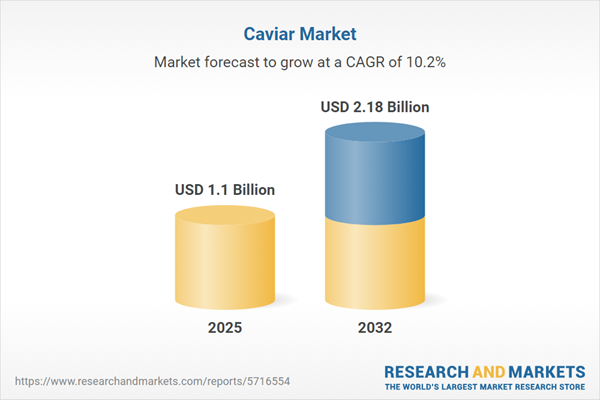Speak directly to the analyst to clarify any post sales queries you may have.
Senior leaders in the global caviar market are responding to intensifying regulatory requirements and evolving customer expectations by prioritizing transparency, comprehensive compliance, and advanced supply chain systems. Enhanced traceability and adoption of innovative technologies are influencing procurement standards and risk management. These shifts are transforming how brands position themselves within an increasingly competitive and dynamic environment.
Market Snapshot: Global Caviar Market Outlook
In 2024, the global caviar market achieved a value of USD 1 billion with a compound annual growth rate (CAGR) of 10.21%. Market expansion remains linked to continuous demand from luxury culinary and hospitality sectors, where refined supply chain strategies are essential for differentiation. Senior executives are pursuing operational excellence through digital transformation and greater transparency, resulting in improved adaptation to shifting regulations and optimized sourcing decisions. Across the value chain, both suppliers and buyers increasingly demand robust sourcing verification, shaping contemporary approaches to secure lasting competitive benefits. Today’s leadership is cultivating innovation, distinctive brand positioning, and resilience to market fluctuations.
Scope & Segmentation: Global Caviar Market
This analysis guides organizational leaders seeking to strengthen procurement efficiency and sales performance in the luxury food segment. The segmentation below highlights growth drivers and actionable process enhancements relevant to decision-making:
- Type: Beluga, Ossetra, and Sevruga caviar are foundational for brands seeking premium status. Specializing in these types reinforces customer loyalty and targets sophisticated market segments requiring unique provenance and consistency.
- Form: Fresh, frozen, and pasteurized options support seamless distribution and adaptable storage strategies. These forms help brands serve broad channels, including retail, wholesale, and digital platforms, by extending product shelf life and accessibility.
- Application: Usage spans luxury hotels and restaurants, as well as an expanding at-home dining community. Custom packaging and personalization enable suppliers to reach both established and emerging markets.
- Distribution Channel: Specialty retailers, major chains, and e-commerce are critical for scaling reach. These avenues enable B2B and B2C partnerships, broadening access and diversifying customer bases.
- Region: The Americas, Europe, Middle East & Africa, and Asia-Pacific regions display distinct consumption patterns and compliance priorities. Regional analysis supports adaptation in regulatory approaches and operational risk management.
- Featured Companies: Petrossian SA, Calvisius Caviar GmbH, American Caviar Company LLC, Tsar Nicoulai Caviar Inc., Caviar House & Prunier Group GmbH, Sasanian Caviar PLC, Kaviari SAS, Pars Caviar Production Company, Wild Caviar Company Ltd., and Caviar Russe LLC represent leadership in process innovation and collaboration.
Key Takeaways for Senior Decision-Makers
- Responsible sourcing and consistent compliance with regulatory frameworks enhance market credibility and bolster stakeholder trust throughout the supply chain.
- Adoption of advanced traceability and sustainable aquaculture practices strengthens supplier relations and improves procurement dependability in complex networks.
- Expanding product variety and deploying tailored packaging solutions help reach new market segments and satisfy shifting buyer requirements in dynamic landscapes.
- Implementing digitalization and IoT in supply chain management sharpens operational efficiency and accelerates both B2B and B2C response capabilities.
- Building strategic alliances with key suppliers and distributors increases resilience and supports continuity in the face of regulatory and supply disruptions.
- Leveraging blockchain and modern logistics protects sensitive data and streamlines cross-border compliance, reducing exposure to international trade risks.
Tariff Impact and Adaptation Strategies for the Caviar Industry
Recent changes to United States import tariffs have led caviar suppliers to revisit sourcing and renegotiate international agreements. To address regulatory and operational pressures, many companies are upgrading supply chain workflows and introducing innovative packaging formats. These proactive strategies help maintain pricing consistency and minimize disruptions, supporting seamless procurement and distribution across diverse channels.
Methodology & Data Sources
This report integrates senior executive interviews, regulatory reviews, and direct operational assessment. By applying scenario analysis and thorough data triangulation, the research provides leadership teams with actionable intelligence to guide strategic supply chain decisions in the luxury food sector.
Global Caviar Market: Why This Report Matters
- Enables leaders to identify innovation opportunities with clear, segmented insights, optimizing sourcing and distribution decisions.
- Highlights how digitalization and regulatory expertise can reinforce resilience and support quality decision-making in the luxury foods category.
- Delivers actionable direction to enhance procurement agility and operational flexibility in rapidly evolving global markets.
Conclusion
Senior executives can leverage the insights and benchmarks in this report to drive sustainable growth and advance organizational objectives in the global caviar market.
Additional Product Information:
- Purchase of this report includes 1 year online access with quarterly updates.
- This report can be updated on request. Please contact our Customer Experience team using the Ask a Question widget on our website.
Table of Contents
3. Executive Summary
4. Market Overview
7. Cumulative Impact of Artificial Intelligence 2025
Companies Mentioned
The companies profiled in this Caviar market report include:- Petrossian SA
- Calvisius Caviar GmbH
- American Caviar Company LLC
- Tsar Nicoulai Caviar Inc.
- Caviar House & Prunier Group GmbH
- Sasanian Caviar PLC
- Kaviari SAS
- Pars Caviar Production Company
- Wild Caviar Company Ltd.
- Caviar Russe LLC
Table Information
| Report Attribute | Details |
|---|---|
| No. of Pages | 193 |
| Published | October 2025 |
| Forecast Period | 2025 - 2032 |
| Estimated Market Value ( USD | $ 1.1 Billion |
| Forecasted Market Value ( USD | $ 2.18 Billion |
| Compound Annual Growth Rate | 10.2% |
| Regions Covered | Global |
| No. of Companies Mentioned | 11 |









